fluid inclusions
- 格式:pdf
- 大小:284.78 KB
- 文档页数:6

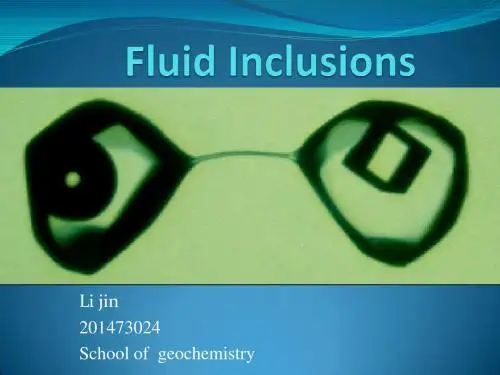




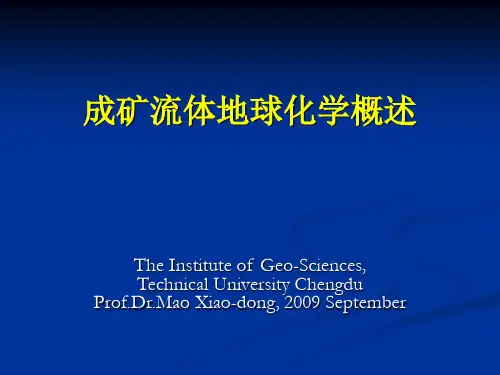
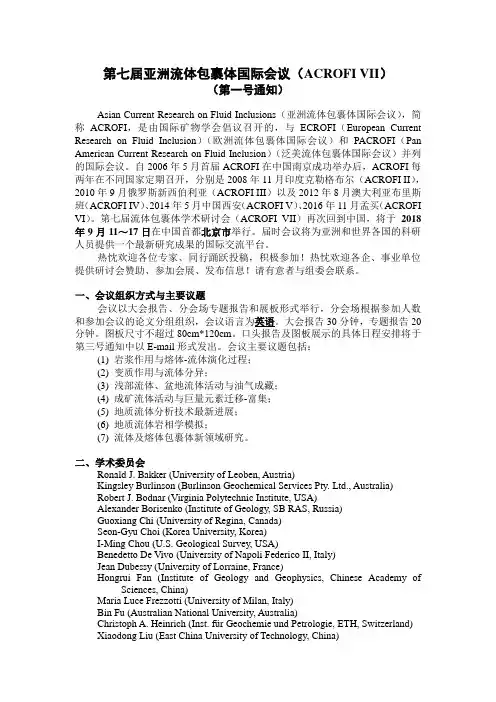
第七届亚洲流体包裹体国际会议(ACROFI VII)(第一号通知)Asian Current Research on Fluid Inclusions(亚洲流体包裹体国际会议),简称ACROFI,是由国际矿物学会倡议召开的,与ECROFI(European Current Research on Fluid Inclusion)(欧洲流体包裹体国际会议)和PACROFI(Pan American Current Research on Fluid Inclusion)(泛美流体包裹体国际会议)并列的国际会议。
自2006年5月首届ACROFI在中国南京成功举办后,ACROFI每两年在不同国家定期召开,分别是2008年11月印度克勒格布尔(ACROFI II),2010年9月俄罗斯新西伯利亚(ACROFI III)以及2012年8月澳大利亚布里斯班(ACROFI IV)、2014年5月中国西安(ACROFI V)、2016年11月孟买(ACROFI VI)。
第七届流体包裹体学术研讨会(ACROFI VII)再次回到中国,将于2018年9月11~17日在中国首都北京市举行。
届时会议将为亚洲和世界各国的科研人员提供一个最新研究成果的国际交流平台。
热忱欢迎各位专家、同行踊跃投稿,积极参加!热忱欢迎各企、事业单位提供研讨会赞助、参加会展、发布信息!请有意者与组委会联系。
一、会议组织方式与主要议题会议以大会报告、分会场专题报告和展板形式举行,分会场根据参加人数和参加会议的论文分组组织,会议语言为英语。
大会报告30分钟,专题报告20分钟。
图板尺寸不超过80cm*120cm。
口头报告及图板展示的具体日程安排将于第三号通知中以E-mail形式发出。
会议主要议题包括:(1) 岩浆作用与熔体-流体演化过程;(2) 变质作用与流体分异;(3) 浅部流体、盆地流体活动与油气成藏;(4) 成矿流体活动与巨量元素迁移-富集;(5) 地质流体分析技术最新进展;(6) 地质流体岩相学模拟;(7) 流体及熔体包裹体新领域研究。
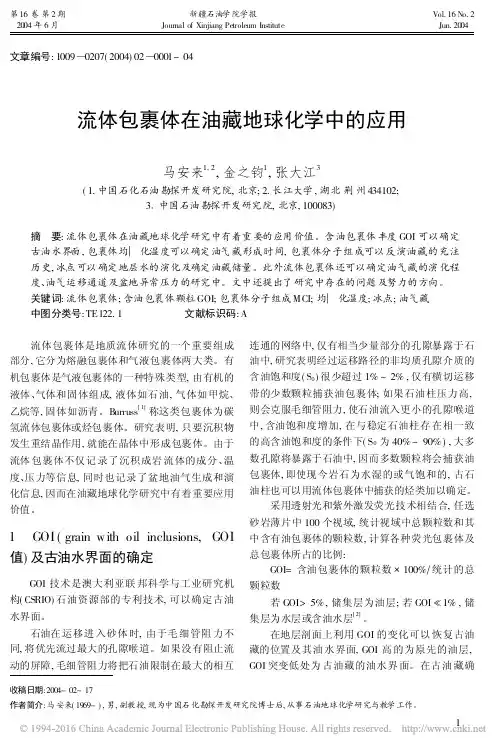
收稿日期:2004-02-17作者简介:马安来(1969-),男,副教授,现为中国石化勘探开发研究院博士后,从事石油地球化学研究与教学工作。
文章编号:1009 0207(2004)02 0001-04流体包裹体在油藏地球化学中的应用马安来1,2,金之钧1,张大江3(1.中国石化石油勘探开发研究院,北京;2.长江大学,湖北荆州434102;3 中国石油勘探开发研究院,北京,100083)摘 要:流体包裹体在油藏地球化学研究中有着重要的应用价值。
含油包裹体丰度GOI 可以确定古油水界面,包裹体均一化温度可以确定油气藏形成时间,包裹体分子组成可以反演油藏的充注历史,冰点可以确定地层水的演化及确定油藏储量。
此外流体包裹体还可以确定油气藏的演化程度、油气运移通道及盆地异常压力的研究中。
文中还提出了研究中存在的问题及努力的方向。
关键词:流体包裹体;含油包裹体颗粒GOI;包裹体分子组成MCI;均一化温度;冰点;油气藏中图分类号:TE122.1 文献标识码:A 流体包裹体是地质流体研究的一个重要组成部分,它分为熔融包裹体和气液包裹体两大类。
有机包裹体是气液包裹体的一种特殊类型,由有机的液体、气体和固体组成,液体如石油,气体如甲烷、乙烷等,固体如沥青。
B urruss[1]称这类包裹体为碳氢流体包裹体或烃包裹体。
研究表明,只要沉积物发生重结晶作用,就能在晶体中形成包裹体。
由于流体包裹体不仅记录了沉积成岩流体的成分、温度、压力等信息,同时也记录了盆地油气生成和演化信息,因而在油藏地球化学研究中有着重要应用价值。
1 GOI (grain with oil inclusions,GOI 值)及古油水界面的确定GOI 技术是澳大利亚联邦科学与工业研究机构(CSRIO)石油资源部的专利技术,可以确定古油水界面。
石油在运移进入砂体时,由于毛细管阻力不同,将优先流过最大的孔隙喉道。
如果没有阻止流动的屏障,毛细管阻力将把石油限制在最大的相互连通的网络中,仅有相当少量部分的孔隙暴露于石油中,研究表明经过运移路径的非均质孔隙介质的含油饱和度(S 0)很少超过1%~2%,仅有横切运移带的少数颗粒捕获油包裹体;如果石油柱压力高,则会克服毛细管阻力,使石油流入更小的孔隙喉道中,含油饱和度增加,在与稳定石油柱存在相一致的高含油饱和度的条件下(S 0为40%~90%),大多数孔隙将暴露于石油中,因而多数颗粒将会捕获油包裹体,即使现今岩石为水湿的或气饱和的,古石油柱也可以用流体包裹体中捕获的烃类加以确定。

英文地质书刊中常用词组Aa bit of 一点,少量的above all 尤其是,最重要的是according as 依照,随。
而定according to 依照,根据account for 说明,解释act as 起。
作用,担任act(up)on对。
起作用a few 有几个,有一些after all 毕竟,终究a good(great)deal of 很多a good(great)many of 很多agree to 答应,承认agree with 同意。
的意见,与。
一致a little 一点;一会儿all at once 突然all but差不多,几乎,都all over 到处;完全;结束all over the world全世界all the same完全一样,依然all the time始终,一直all the while始终,一直all through从头到尾,始终along with与。
一道;随着a lot of大量,许多amount to总计,等于and so forth等等and so on等等and the like等等answer to符合,与。
一致a number of若干apart from 除。
外,且不说as a matter of course当然的事as a matter of fact 实际上,其实as a result结果as a result of由于。
结果as a rule通常as a whole整个说来as concerns至于,关于as early as 早在a series of一系列as far as远至,到。
程度;尽。
所as far as。
be concered就。
而论,对。
来说as far as。
goes就。
而论as far back as早在。
(就),远在。
(就)as follows 如下,如下所述as for至于,就。
而论as good as和。
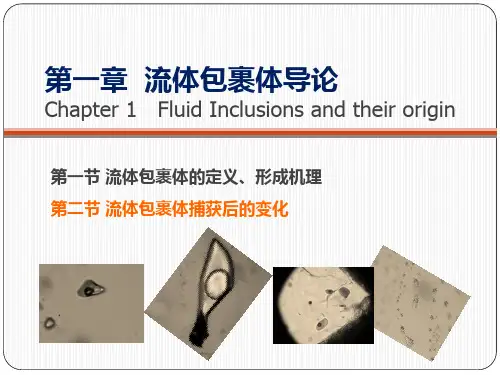
【word】流体包裹体激光拉曼光谱分析原理、方法、存在的问题及未来研究方向流体包裹体激光拉曼光谱分析原理、方法、存在的问题及未来研究方向年地质论评GEOLOGICALREVIEWV01.55No.6NOV.2009流体包裹体激光拉曼光谱分析原理,方法,存在的问题及未来研究方向陈勇?,ERNSTA.JOBurke’1)中国石油大学(华东)地球资源与信息学院,中国山东青岛,2665552)阿姆斯特丹自由大学地球科学系微量分析实验室,荷兰阿姆斯特丹内容提要:国内外在流体包裹体激光拉曼光谱研究方面取得了大量的成果.本文回顾了流体包裹体激光拉曼光谱分析技术的发展历史,介绍了流体包裹体激光拉曼光谱技术定性和定量分析的原理和方法,指出了该技术存在的问题及未来研究方向.流体包裹体激光拉曼光谱分析主要受到样品,荧光,同位素,光化学反应,水溶性物质信号弱,气相水及水合物,子矿物等因素的影响.由于用来进行定量分析的拉曼散射截面参数明显受到压力影响,加上峰面积计算不规范化使得目前的流体包裹体激光拉曼光谱分析结果可靠性有待于重新审视.未来流体包裹体拉曼光谱分析技术应当在完善不同标准体系和标准物质光谱数据的基础上,针对不同类型包裹体采用采取不同条件,分析结果将在准确定性的基础上从相对定量向绝对定量发展.关键词:流体包裹体;激光拉曼光谱;定量分析;研究进展;未来研究方向激光拉曼光谱技术应用于流体包裹体已有30多年的历史,由于该技术可以实现对单个包裹体非破坏性分析,并可定量获取包裹体中成分含量,因而受到广大流体包裹体研究者的青睐.尽管国内外已有大量关于流体包裹体激光拉曼光谱分析的研究文章和数据报道,但目前仍有一些研究者和分析测试人员对数据的准确性和可靠性不够了解,甚至在发表文章报道时出现错误的解释.笔者等根据多年的实验分析和研究经历,介绍了激光拉曼光谱技术分析的基本原理和方法,并提出几个有关流体包裹体激光拉曼光谱分析的关键问题与广大同行探讨,同时指出了该技术今后的研究和发展方向.1流体包裹体激光拉曼光谱分析技术研究历史回顾Rosasco等(1975)最早发表了天然流体包裹体的拉曼分析结果,接下来是Rosasco和Roedder(1979)及Dhamelincourt等(1979)人的报道,随后Beny等(1982)和Touray等(1985)分别发表了关于流体系统和拉曼光谱分析方法更全面的研究成果.这些报道不仅指出了这种新方法在流体包裹体分析的可能性,也为用有效截面积进行流体包裹体定量分析指明了道路.Schrotter和Klocner(1979)的文章对流体组成的截面积进行了讨论,尽管地球科学的拉曼分析工作者经历了10多年才完全理解它的内容,但这篇文章却是显微拉曼光谱技术发展历程上的一个重大突破(Dubessy等,1999).最初将拉曼光谱仪应用于流体包裹体是Pasteris等(1986)以及Burke和Lustenhouwer(1987).Wopenka和Pasteris(1986,l987),Seitz等(1987),特别是Pasteris等(1988)系统地讨论了仪器的局限性和最优分析条件.在流体包裹体显微拉曼光谱定量分析技术尝试初期最具有纪念意义的工作是Kerkho{(1988)关于CO一CH一N体系的研究,同时也包括Dubessy等(1989)的评述,这篇评述包括讨论和对c—O—H—N,S流体分析的必要校正.在国内,黄伟林等(1990),徐培苍等(1996)较早报道利用U一1OO0型激光拉曼光谱仪进行了流体包裹体分析,并对定量分析方法进行了较详细的讨论.近年来国内一些学者也曾对流体包裹体拉曼光谱分析技术研究进展作过一些评述(陈晋阳等,2002;陈勇等,2007),此外还有大量流体包裹体拉曼光谱分注:本文为国家”863’’课题(编号2007AA06Z210),山东省自然科学基金(编号:Y2oO8E25)和油气资源与探测国家重点实验室开放课题(编号2009006)资助的成果.收稿日期:2008—09—10;改回日期:200905—20;责任编辑:章雨旭.作者简介:陈勇,男,1976年生.博士,副教授.主要从事流体包裹体和油气地球化学研究工作.通讯地址:266555,中国石油大学(华东)地球资源与信息学院;电话:0546—8393548;Email:yongchenzy@.ca.地质论评2009正析的数据报道.2拉曼光谱分析基本原理2.1拉曼光谱产生原理早在1923年,A.Semkal等人在理论上预言:光通过介质时,由于它们之间的相互作用,可以观测到光频率发生变化,相位也发生无规律的变化.而1928年,印度物理学家C.V.Raman和K.s.Krishman首先在CC1液体的散射光中发现了频率变化,这就是最早发现的拉曼现象.为纪念印度物理学家Raman,这种现象就称为Raman散射.当一束频率为u.的单色光照射到物质(固体,气体,液体)上时,一部分被透射,一部分被反射,还有一部分向四周散射.在散射光中,除了与人射光频率相同的光外,还包含有一系列频率为??u的光,这部分频率有变化的光就是拉曼散射光(其中?u即为拉曼位移).根据量子理论,频率为的入射单色光,可看作是具有能量h的光子.当光子与物质分子碰撞时,有两种情况,一种是弹性碰撞;一种是非弹性碰撞.在弹性碰撞中,只改变了光的方向,而光子的能量没有发生改变,光的频率也不会改变,称为瑞利散射.在非弹性碰撞中,光子运动的方向和能量都发生了改变,因此光的频率也发生变化,这就是拉曼散射,频率之差?u叫作拉曼位移.拉曼散射光对称的分布在瑞利散射光两侧(图1),其强度要比瑞利光弱很多,通常为瑞利光的10,1o.其中波长比瑞利光长的拉曼光叫斯托克斯线(Stokes线),波长比瑞利光短的拉曼光叫反斯托克斯线(anti—Stokes线).V.-?1,+——一v———v【】+?1,图1光散射现象Fig.1Phenomenonoflightscattering拉曼散射产生的根本原因是当光照射物质时,如果物质分子的某种振动可以引起分子极化率的改变,则就会产生拉曼散射现象.仅当分子极化率有变化时才会引起拉曼散射现象,如果分子的振动模式不能改变分子极化率,将不会发生拉曼散射现象, 通常把能够产生拉曼散射的分子振动称为拉曼活性振动.2.2拉曼光谱定性分析原理在拉曼散射中,拉曼位移?与入射光的频率无关,仅取决于分子本身的固有振动和转动能级结构,因此,不同物质具有不同的拉曼位移.尽管对同一种物质用不同频率光照射时产生的拉曼散射光不相同,但是其拉曼位移却是一个确定的值.每一种具有拉曼活性的物质都有其特定的拉曼光谱特征, 根据物质的特征拉曼光谱可以辨认出物质种类,这就是拉曼光谱定性分析的基本原理.在利用拉曼光谱进行物质鉴定时,只需找出拉曼谱图中的特征光谱,就可以识别物质的种类.相同化学组成而晶体结构不同的物质,往往由于其分子结构不同而具有不同的拉曼光谱.由于拉曼光谱为我们提供了物质分子结构的信息,所以,利用拉曼光谱技术可以获取流体包裹体中成分的分子信息,从而识别其中的流体组成类型.2.3拉曼光谱定量分析原理尽管拉曼位移与入射光强度无关,但拉曼散射的强度却与分子的浓度,入射光强度等因素有关. 据朱自莹(1998),拉曼散射光通量可表示为:一j5.sKNHL47sin(4/2)(1)式中为在垂直入射光束方向上通过聚焦透镜所收集的拉曼散射光的通量();屯为入射光束照射到样品上的光通量(W);sK为拉曼散射系数,约等于1O.,10.tool?L-./Sr:N为单位体积内的分子数;H为样品的有效长度;L为考虑到折射率和样品内场效应等因素影响的系数;a为拉曼光束在聚焦透镜方向上的半角度.由(1)式分析可以知道,当实验条件不变时,拉曼散射光的通量与单位体积内的分子数成正比,这为拉曼定量分析提供了依据.3流体包裹体拉曼光谱分析原理与方法3.1流体包裹体中的拉曼活性物质流体包裹体可能含有固态,液态或气态的多种物质,但并非所有的原子和分子都具有拉曼效应.Roedder(1990)总结了一些给定包裹体分析可以完成的分析物质.Buker(2001)在Roedder的基础上第6期陈勇等:流体包裹体激光拉曼光谱分析原理,方法,存在的问题及未来研究方向853进行了修改,他指出流体包裹体中的常见物质及其拉曼活性,具体内容见表1.由此可见,流体包裹体中仅有很少一部分物质是可以用拉曼光谱定量分析,它们是一些多原子气体和溶液中极少的几种多核物质.尽管许多物质具有拉曼活性,并可以通过它们的拉曼特征峰证实其存在,但对一些物质(如溶液中的阳离子),只有在低温下才可能检测到它们的水合物.所以,拉曼光谱技术主要可以成功地对流体包裹体或超临界包裹体中的气相进行分析(气相不包括水蒸气)(Burke, 2001).而对于多相水溶液包裹体中的液相通常只能得到定性数据.对于气相,如果扣去少量的水蒸汽(在室温下水的饱和蒸汽压很低)就可以获得定量结果.由于水蒸气的”峰”实际上是一个宽波带,所以是难以用显微拉曼光谱技术定量的.3.2流体包裹体拉曼光谱定量分析方法如果只是定性分析流体包裹体中的拉曼活性物质,仅有它们的特征峰拉曼位移?v就足够了.而定量分析气体或超临界包裹体则需要知道在一定精度条件下的显微光谱仪光谱效率(仪器因子)和不同组分的拉曼散射效率(相当于截面积,)才可能实现.拉曼散射效率参数与波长无关,而拉曼散射效率参数与波长有关,表2中列出了流体包裹体中常见物质的拉曼位移?v,拉曼散射效率(三)和拉曼散射效率(d).表中CO.后的和2为CO:的费米共振双峰.从表2可以看出,不同文献给出的?和?数值上的有些不同.例如大多数学者给出CH的v振动的峰位在2917cm,但一些学者给出在2914cm.实际上拉曼位移对定性和定量分析没有明显的影响,但当用峰位确定包裹体的密度或组分的分压时是非常重要的.在Schrotter和Klocner(1979)发表的论文中列出了不同实验室获得的值,用488和514nm激发光对CH的2917cm峰的六个值分别为:6.8,9.2,8.7和9.1,8.7,9.3;而表1中列出的是它们的平均值(三一8.63).三值是不同拉曼散射截面的相对规一化值,可用于比较不同波长的测试结果.另外,对一定激光波长下获得的气体组分峰面积的计算会用到值和相对拉曼散射截面,这两个值都是相对N的散射效率标准化给表1流体包裹体中常见物质拉曼活性特征Table1TheRamancharacteristicsofcommonmaterinfluidinclusions 室温条件下一般物质相态/类型可半定量分析可定性分析不具备拉曼活性溶剂物质H2o,C02,H2S水溶液中的常见阳离子Na+,K+,Ca,MgHCOa-,coi,HS一,水溶液中的常见阴离子ClHSO~-,s0i室温下液相的物质Li,A1,Fe,B,Ba,Br,Mn,水溶液中的微量元素离子P,F,Si的离子及NH4+高碳数碳氢化合物,乙酸其它盐(酯),草酸盐(酯)主要成分0CO2,CH4,N2H2o室温下的气体或次要成分H2S,C2H6,C3H80C02超临界物质SO2,CO,COS,HzOz高碳数碳氢化合物,He,稀有组分NH3Ar具有拉曼活性的子矿物,室温下的固体物质石墨及含碳物质H20,CO2,H2S,盐(Na,Ca,Mg,Li)的水合物及气低温下的固体物质体(COz,CH4,Nz,Has)水合物地质论评出的(N.的三和d都等于1).Dubessy等(1989)详细阐述了采用值而不用三值的必要性.Schrotter和Klockner(1979)给出和的关系式,Dubessy等(1989)也引用这个公式.但是如果书写过程忽略方程中的分母部分会导致对任何应用都不适合.这个公式的表达式如下:.E1--e-hcvi/kT](2)YOPi,式中和d是对不同的散射值是激光波数(对488nm,514nm和633nm分别为20487cm,19435cm和15802cm),h是普朗克常数(6.626×10Js),c是光速(2.998×10m/s),k是玻耳兹曼常数(1.381×10.J/K),T是绝对温度.用公式(2)获得的值计算时应当注意的是,所有这些值是对低密度流体混合物而言,它们会随压力,温度和流体包裹体的化学组成变化.值得注意的是CO拉曼光谱出现费米振动双峰,两个峰面积的强度比率随密度变化,但两个峰面积之和为常数. Dubessy等(1989)认为混合物中的CO.含量计算应当采用峰面积的总和或d的总和(如对514nm光为2.5).而Seitz等(1996)获得关于CH和CO2费米双峰之和的比率的变化是压力的函数,因此Seitz等(1993)曾指出,仅用CO的2v比用费米双峰之和来确定CO一CH混合物的流体组分更合适.而一个基于Placzck偏振理论的简化公式可用来尝试定量分析一个流体包裹体中出现物质的浓度(Dubessy等,1989),这是目前流体包裹体激光拉曼光谱定量分析的通用公式,该式如下:一(3)x,A.,和已分别是a组分的浓度(以摩尔分数表示),峰面积,拉曼散射截面和仪器效率.A峨和代表包裹体中所有检测物质的值.峰面积应当相对激光功率和信号积分时间进行规一化.举个例子: 对一个单相超临界流体包裹体拉曼分析得到光谱峰面积分别为CO在1388cm(4386计数)和1285cm(2580计数),N2在233lcm(314计数)和CH在2917cm(9834计数).由于CO2,N2和表2包裹体中常见物质的拉曼位移(Av),与波长无关的相对拉曼散射截面参数(J,与波长有关的相对散射截面参数(J(据Burke,2001JTable2Ramanshifts(?’,).wavelength—independentrelativeRamanscatter ingcross-sections{,,~)andwavelength-dependentrelativeRamanscattering cross-sections()ofcommonfluidspeciesininclusions-withsomereferences Species?三(488nm)(514nm)(633rim)C0S857S0983HSO1050S021l514.O35.25.35.6“011285O.8O1.01.01.1CO22val3881.231.51.51.6CO22v213701.5l_51.6HCO136O0215551.031.21.21.3C02143O.9O0.900.90O.9ON22331111lHS一2574H2SLiquid258OH2Sinwater259OH2S26l16.86.46.46.2C3H82890CHa29178.637.67.57.2 CaH6295413H2Oliquid3219NH333366.325.05.04.6H2Ovapour36573.29H241563.542.32.32.0CH的值分别为2.5(两个峰之和),1和7.5;而光谱仪在CO,CH和N.峰位的仪器效率因子值分别为0.5,1和1 (值由合成气体混合物校正过),简化就得到下面的峰面积(Burke,2001):CO2:[(4386+2580)/(2.5×0.5)]=5572.8N2:[(314)/(1×1)]一314CH:[(9834)/(7.5×1)]一1311.2利用公式(3)计算得到的分析结果为,n(CO):78,,z(N.):4,(CH):18,但这个结果是基于这样一个假设:即低密度的值可以应用到具有明显更大密度的流体.这就是激光拉曼光谱定量分析流体包裹体气体成分的计算方法.3.3流体包裹体激光拉曼光谱分析方法的校正激光拉曼光谱定性分析的第6期陈勇等:流体包裹体激光拉曼光谱分析原理,方法,存在的问题及未来研究方向855校正工作相对比较简单,只要在测试样品之前用单晶硅片对仪器进行校正就可以了.而定量分析的校正相对较复杂,如果能够准确知道不同流体物质的相对拉曼散射面积(),并且仪器光学效率是确定的(用标准灯),那么在理论上激光拉曼光谱仪定量分析的准确性是可以校正的.由于a随温度,压力和具体的流体组成变化,而且又缺少有效的偏振扰频器,Pasteris等(1988)就提出了拉曼光谱仪的经验校正法,即用已知组成和压力的流体混合物进行校正.由于缺少标样,评价拉曼结果的唯一经验方法是用天然或人工合成流体包裹体的显微测温数据来比较.Wopenka和Pasteris(1986)最早用C02一CH人工合成流体包裹体进行了校正.由于在多数情况下得到的拉曼数据与测温结果实质上是一致的,这就导致了一些人对于仪器校正因子的过度信任,Dubessy(1989)就指出了随便用与波长无关的拉曼散射截面代替与波长有关的计算方法不可靠.后来的研究明显表明,仅用三得到的一些拉曼结果在合理的误差范围内.Wopenko和Pasteris (1987)及Kerkho{(1988)分别最早提出了用焊封毛细石英管内的已知成分气体混合来进行经验校正的方法.Chou等(1990)提出了用高压腔的方法进行校正.目前许多拉曼实验室采用kerkhof等(1988) 提出的焊封石英管法或Chou等(1990)提出的焊封硅玻璃管方法来校正仪器.经过校正,流体包裹体拉曼分析的相对误差通常低于5(Burke,2001).4流体包裹体拉曼光谱分析的主要影响因素4.1样品与仪器因素为避免拉曼测试浪费时间,应当选择那些可以获得显微测温数据的包裹体.为达到这个目的,样品需磨成两面抛光,厚度在5O,200am的岩石薄片,理论上也完全适合拉曼分析.这样的薄片不能用易进入样品裂缝或裂隙或带有荧光的粘胶准备. 建议最好采用蜂蜡,因为它不会进入样品,而且易溶于白酒或松节油中(Burke,2001).如果用常见的胶水(如加拿大树胶)制备薄片,那么在进行激光拉曼光谱分析前一定要把薄片取下来清洗干净.一些样品的性质会直接影响拉曼分析:如样品不够透明或薄片抛光得不好就会造成无法观察或无法分析包裹体;514nm的氩离子激光会被红色矿物吸收;高反射率的矿物(如方解石)在深部会造成双图像;由于不透明子矿物在一定程度上吸收激光的能量会使整个包裹体信号变差.目前大多数激光拉曼光谱仪配有高质量的高倍显微镜,物镜可以使激光聚焦到l~2btm,甚至更小.一些透镜带外套(涂层)的物镜可以选择吸收部分拉曼散射光谱,这会降低结果的精度.可以进行拉曼分析的最小流体包裹体取决于多种因素,包括显微镜系统的性质,激光光源,光谱仪的检测器类型,流体的密度,包裹体在样品中的深度,基质的背景信号等.在理想条件下,可以获得石英中100/~m深,2m大包裹体中可靠的定量结果(Burke,2001).有时即使流体包裹体又宽又长,但可能会很薄,由于激光聚焦在垂直方向相对较大,大多数情况会激发包裹体的基质,而不显示包裹体本身特征.由于这些因素,所有包裹体中流体成分应当在不改变位置和激光聚焦深度的条件下测试.每个包裹体都有自己的特点,通常为不规则的几何体, 而且激光聚焦的任意变化都会对包裹体的激发体积估计产生重大影响.而目前新型拉曼光谱仪中采用共焦系统极大地提高了测试小包裹体的可能性. 有时靠近样品表面的小包裹体很可能比深处大包裹体的拉曼信号更强.通常情况下,尽量分析靠近表面的包裹体是流体包裹体拉曼光谱分析的一条重要原则,当包裹体深度超过50/~m就会出现检测问题,特别是如果流体密度不太高的情况就更加难以检测.对于含N:流体,分析包裹体的最佳深度是3O,7Om,这个深度是获得最强的拉曼峰信号与避免物镜和样品之间空气中的氮气干扰的最佳深度, 但共焦拉曼光谱仪一般不会出现这种背景干扰问题(Burke,2001).增强激光功率或采用更长的测试时问可以增大样品中低密度或埋藏较深包裹体中的拉曼散射信号.由于样品的性质不同,包裹体和仪器就决定了一系列分析条件选择,以便保证可以检测所有组分.还有一些需要考虑的问题,如包裹体是否可以抵制激光导致的热量增加?以及在可能的时问限制内能够采集几个波段的光谱?获取低密度包裹体中的成分信息仍然是包裹体拉曼光谱分析的一个技术难题.4.2荧光现象在流体包裹体(特别是有机包裹体)拉曼光谱分析时遇到一个常见而又头疼的问题就是荧光现象.荧光的强度一般比拉曼信号大几个数量级,相对较弱的拉曼信号可能会被荧光完全掩盖.有三个方面因素可能会引起荧光,包括表面,基质矿物及流体包裹体.表面荧光的诱导因素较多,最常见原因是矿地质论评物和由样品准备所用的粘合剂没有完全洗净的残余物引起的,也可能是用记号笔在包裹体附近划圈的含碳氢官能团墨水引起,甚至还有可能荧光仅仅是不小心印在样品上的指纹引起的.常见发荧光的矿物有萤石,方解石和斜长石,甚至有时石英也会发荧光.裂缝和裂隙中充填了发荧光的粘合剂也会妨碍分析.如果流体包裹体中含有环状或芳环烃类,或者荧光性子矿物,通常都会引发荧光(Burke, 2001).消除荧光除了采用共焦拉曼光谱仪外,还有其它几种方法可以避免荧光效应,如清洁样品表面,对将用激光束分析的地方加热几分钟有时可以大大减低矿物的荧光.而发荧光的流体包裹体通常不能用传统可见光拉曼光谱仪进行分析,如单个有机包裹体用传统拉曼光谱仪标定有一定困难,即便用傅立叶转换红外光谱仪或近红外傅里叶转换拉曼光谱仪也如此.然而,对于傅立叶转换红外光谱仪或近红外傅里叶转换拉曼光谱仪,包裹体分析的最小尺寸要求比可见光拉曼光谱仪能够分析的尺寸大将近一个数量级.另一个可能的办法就是采用时间高分辨可见光拉曼光谱仪,因为荧光效应发生比拉曼效应晚一些,这样就可以在检测器被荧光覆盖之前获取拉曼信号.此外,由于荧光强度与激发光有关,有时减弱激发光强度在一定程度上也可以减弱荧光的影响,但同时也减弱了包裹体中成分的拉曼信号,需要找到合适的激发光强度.目前有研究发现在低温下分析也可能减小荧光的影响.4.3同位素的影响在流体包裹体中最常见而含量较高的同位素组合就是c和”C,主要影响CO.的含量分析.CO的拉曼光谱包含四个峰,即费米共振双峰(1285em的1和1388em的2v.),及费米双峰外的两个”热峰”,分别为1265cm和141Ocm一.很多包裹体在2v.峰肩旁出现一个附加峰,在1370cm.这个峰是由于.C0的2.振动引起的,它的强度通常非常低,而它的不规则性会影响CO 定量测定(Garrabos等,1989).Rosasco等(1975) 确定”CO2的精度为20%o,而Dhamelincourt等(1979)的精度仅为37‰.最新的拉曼仪器及检测器应当考虑提高这种潜在的拉曼分析及研究应用的精度.我国学者赫英等(1998)曾尝试用拉曼光谱技术测定包裹体中”CO.的含量.此外,碳同位素在有机物测试中的影响还有待于进一步分析.4.4光化学反应我们知道,一些物质在光的作用下会发生化学反应,这类反应也可能在包裹体进行拉曼测试时发生.通常情况下激光的热量不会传到流体包裹体, 即便是室温下接近临界点的两相COz流体包裹体也不会被激光辐射均一化.Rosso和Bodnar(1995) 曾指出激发体积中的激光诱导加热不是很重要.然而,如果包裹体中含有吸收激光的粒子(不能用显微镜看见),那么情况就会完全改变,会完全损耗或爆裂,然后流体快速流出,有时可以看见包裹体反应的结果.Rosasco等(1975)指出,分析含有CH和高碳烃的包裹体时通常可以看到一个由于有机物的聚合导致不透明物质沉淀的现象.例如C0z—CH体系包裹体的一个组分含量在3O,70时会发生一个特殊反应,这种CO一CH组成在许多高密度包裹体室温下不能共存,它们会发生如下反应(Burke,2001):CO+CH一2H20(L)+2C由于石墨的核能高,所以石墨形成可能滞后(推迟),但是如果在当时温度下如果有微小不透明颗粒出现,就可能引发这个反应,因为该反应消耗的气相中两组分的量相同,所以反应就会一直持续到较少的一种组分耗完为止.为了避免获取完全错误的浓度值,CO一CH包裹体在拉曼光谱分析过程中应当注意上述现象.实际上,有时即便在已经有石墨粒子存在的情况下,上述反应也不一定会发生.Huizenga等(1999)的研究表明,在测试一组来自Zimbabwe剪切带中55个石英中的(CO.一CH一H(),C)包裹体时只有2个包裹体发生反应,可能是因为水可以导热而使反应不发生.因此,激光加热对”干”蒸汽相包裹体中固体物的影响比”湿”液体相中包裹体中固体物的影响更明显.Seitz等(1993)曾观察到充满CO和CH混合物的石英管中发生的另一个光化学反应,在激光作用下形成了发强荧光的黄色芳香烃液滴.笔者曾用激光拉曼光谱分析原油时发现,在激光热效应作用下由于有机物的挥发而在样品上出现一个小洞.4.5盐类物质的弱信号问题水溶液包裹体含有的物质一般比气相包裹体种类多.多原子物质容易得到拉曼信号,但是许多水溶液中的盐类物质难以得到清楚的拉曼信号.Dubessy等(1989,1992)指出PO:一的浓度在地质流体中通常非常低,NO;是一种不稳定物种,co;一仅在高pH条件下出现(现实中极少),而在1018第6期陈勇等:流体包裹体激光拉曼光谱分析原理,方法,存在的问题及未来研究方向857cm附近的HCOa低(弱)拉曼散射信号常会被石。
五篇american mineralogist -回复American Mineralogist is a highly esteemed scientific journal that focuses on the study of minerals and their properties. In this article, we will explore five diverse topics from recent issues of American Mineralogist and provide a comprehensive overview of each subject.Topic 1: Mineral fluid inclusions and their role in understanding Earth's processesMineral fluid inclusions are small pockets of fluids trapped within minerals. By studying these inclusions, researchers gain valuable insights into the conditions and processes that occurred during mineral formation. This topic discusses various analytical techniques used to investigate fluid inclusions and their significance in understanding geological processes such as magma formation, hydrothermal transport, and ore deposition.Topic 2: Crystal structures of zeolites and their applications in industrial processesZeolites are crystalline materials with unique porous structures, making them highly effective in various applications. This section focuses on recent advancements in understanding the crystal structures of zeolites and how this knowledge can be harnessed for industrial processes such as gas separation, catalysis, andwastewater treatment. The article will discuss the use of X-ray diffraction, electron microscopy, and computational modeling to investigate zeolite structures.Topic 3: The role of minerals in environmental geochemistryMinerals play a crucial role in the geochemical cycling of elements in the environment. They act as repositories, adsorbents, and sources of various elements, affecting ecosystems and human health. This section examines the impacts of minerals on environmental processes, such as soil formation, pollutant retention, and nutrient availability. The article will also discuss the use of mineral-based remediation techniques to mitigate environmental contamination.Topic 4: Mineral physics and its contribution to understanding planetary interiorsMineral physics explores the behavior and properties of minerals under extreme conditions, such as high pressures and temperatures. This topic delves into recent advances in experimental techniques, including laser-heated diamond anvil cells and synchrotron-based X-ray diffraction, that enable scientists to recreate planetary interior conditions in the lab. The article will highlight how these studies improve our understanding of Earth's core, mantle dynamics, and even the geological histories of otherplanets.Topic 5: Evolution of mineralogy as a disciplineThis section provides an overview of the historical developments and milestones that shaped mineralogy as a scientific discipline in America. It will explore famous American mineralogists, such as James Dwight Dana and George Frederick Kunz, and their contributions to the field. Additionally, the article will discuss current challenges and opportunities faced by mineralogists in the modern era, including emerging analytical techniques and interdisciplinary collaborations.In conclusion, this article has examined five intriguing topics recently published in American Mineralogist. By covering subjects ranging from fluid inclusions to mineral physics and the historical evolution of mineralogy, we hope to provide a comprehensive overview of the diverse aspects of this fascinating field. The understanding of minerals and their properties contributes to a deeper understanding of Earth's processes, environmental geochemistry, industrial applications, planetary science, and the fascinating history of scientific discovery.。
高温高压法名词解释汇总高温高压法名词解释汇总在科学研究和工程实践中,高温高压法(High-temperature high-pressure,简称HTHP)是指通过提高温度和压力,来模拟或制备高温高压环境下的物质行为和反应过程的一种实验手段或工艺方法。
本文将对与HTHP法相关的关键名词进行解释和梳理,以帮助读者更好地了解该领域的基本概念和术语。
一、高温高压实验装置1. 高温高压反应器(High-temperature high-pressure reactor):用于在高温高压环境下进行物质反应或性质研究的实验设备,通常由耐高温高压的材料如不锈钢制成。
2. 高温高压密封装置(High-temperature high-pressure sealing device):用于保持高温高压反应装置内部环境的密封设备,通常采用金属密封或垫片密封等方式,以确保反应安全和装置效能。
3. 加热与冷却系统(Heating and cooling system):用于对高温高压反应器进行加热或冷却的装置,常见的方式包括电加热、冷却水循环等。
4. 压力控制系统(Pressure control system):用于控制高温高压反应器内部压力的装置,常见的方式包括压力传感器、液体泵等。
二、高温高压实验条件1. 高温(High temperature):指高于室温的环境温度,通常在100°C以上。
高温条件下,物质的分子间作用力减小,分子热运动增强,从而影响物质的性质与反应速率。
2. 高压(High pressure):指大于环境大气压的压力,通常在1 MPa(兆帕)及以上。
高压条件下,物质的密度增大,分子间碰撞频率增加,从而影响物质的溶解性、相变行为和反应速率。
三、高温高压法应用领域1. 高温高压合成(High-temperature high-pressure synthesis):指在高温高压条件下制备各类物质的合成方法。
第48卷 第4期Vol.48, No.4, 403–4192019年7月GEOCHIMICAJuly, 2019收稿日期(Received): 2018-09-29; 改回日期(Revised): 2018-11-06; 接受日期(Accepted): 2018-11-30 基金项目: 国家自然科学基金面上项目(41573054)作者简介: 杨源显(1995–), 男, 硕士研究生, 矿物学、岩石学、矿床学专业。
E-mail: 2229778928@ * 通讯作者(Corresponding author): WANG Xiao-lin, E-mail: xlinwang@; Tel: +86-25-89680867Geochimica ▌ Vol. 48 ▌ No. 4 ▌ pp. 403–419▌ July, 2019应用拉曼光谱定量分析流体中硫酸盐质量摩尔浓度:内标选择和流体组分对分析结果的影响杨源显1, 王小林1,2*, 席斌斌3, 丘 靥1,高婉露1, 万 野1, 李 真4(1. 南京大学 地球科学与工程学院, 江苏 南京 210023; 2. 南京大学 能源科学研究院, 江苏 南京 210023; 3. 中国石化 石油勘探开发研究院 无锡石油地质研究所, 江苏 无锡 214151; 4. 科廷大学 应用地质学系 地球科学研究所, 澳大利亚 珀斯 6485)摘 要: 硫酸盐是地质流体中重要的组成部分, 流体包裹体是反映地质流体组分最直接和有力的指标, 而应用拉曼光谱可以对封存于包裹体中的富硫酸盐流体成分进行定性和定量表征。
本文制备了一系列含一定浓度的Na 2SO 4和Na 2SO 4-NaCl 溶液的熔融毛细硅管胶囊, 应用高分辨率激光拉曼光谱仪在室温条件下收集了这些溶液中SO 42−的对称伸缩振动(v 1-SO 42−)、水的弯曲振动(v 2-H 2O)和伸缩振动(v s -H 2O)光谱, 建立了硫酸盐质量摩尔浓度(m (SO 42−))与光谱参数之间的定量关系。
流体包裹体硫逸度简介流体包裹体是地球内部和地壳岩石中常见的矿石形式,也被称为矿石的“第五状态”。
其中,硫逸度(Sulfur Fugacity)是流体包裹体中硫化物稳定性的指标,对于矿物析出过程和矿床形成有重要影响。
本文将就流体包裹体和硫逸度的定义、控制因素、测试方法及其地质意义进行探讨。
流体包裹体的定义•流体包裹体是指在岩石形成过程中原位形成的、被流体填充的微小空隙。
这些包裹体可以包含各种类型的流体,如水、盐水、石油和矿化流体等。
•流体包裹体受到围压的保护,温度和压力条件下流体包裹体能够保持稳定,不发生相变、扩散或挥发。
硫逸度的定义•硫逸度是流体包裹体中硫化物稳定性的指标。
它表示了流体包裹体中硫气分压的数值,即硫气逸出的能力。
•硫逸度的大小与硫化物矿物的稳定性相关,当硫逸度增大时,硫化物矿物会溶解,相反,当硫逸度减小时,硫化物矿物会析出。
硫逸度的控制因素•温度:温度是控制流体包裹体硫逸度的重要因素。
随着温度升高,硫气逸出的能力增强,硫逸度增大。
•压力:压力对硫逸度的影响相对较小,但在深部地下时压力的变化会导致硫逸度的变化。
•包裹体成分:包裹体中其他成分的存在也会对硫逸度产生影响,例如氧、碳等元素的含量。
硫逸度的测试方法•在实际研究中,常用的测试方法是流体包裹体中溶解硫化物矿物的析出温度。
•通过高温高压实验或显微镜观察矿物析出的温度,可以推断出流体包裹体中硫逸度的大小。
硫逸度在地质研究中的意义1.硫逸度是岩石中硫化物矿物形成的重要控制因素之一。
通过研究流体包裹体中硫逸度的变化,可以了解矿化流体的演化过程,为找矿工作提供重要线索。
2.硫逸度的大小对矿石晶体中硫的含量有直接影响。
通过测定流体包裹体中硫逸度的大小,可以推断出矿石中硫的含量,为矿石资源评估提供依据。
3.硫逸度还可以指示矿石的成因类型。
不同成因类型的矿石中硫逸度的大小有所差异,通过测定流体包裹体中硫逸度的大小,可以判断矿床的成因类型,为矿床定位和开发提供重要依据。
FLUID INCLUSION STUDY— principle · method · applicationChapter 1Fluid Inclusions and their origin1. What is fluid inclusion ?流体包裹体是指那些矿物形成和改造期间,以流体相的形式(溶液相和熔体相)捕获在矿物生长的各种缺陷中而被保存下来的那部分物质。
要区分两个概念:强调是流体相的形式被捕获,而现在是何种物质形式不重要;以固体相的形式捕获在矿物中的各种细小矿物不是流体包裹体,与流体相同时捕获在一个矿物缺陷中的固相矿物称为“俘虏晶”。
FI 是矿物的一个基本特征,其数量比我们看到的(>1μ)还要多的多。
目前可以被我们研究的FI 一般都要大于5μ,最大的可达几个厘米,越大数量也就越少。
曾估算1cm3 的乳白色石英中含有流体包裹体的数量达109个,而其总体积不会超过这个矿物体积的0.1%。
需要用各种显微技术才能进行研究,且以透明和半透明的矿物为主要对象。
2. How do fluid inclusions formed in minerals ?1)FI 的捕获没有缺陷的理想矿物晶体在自然界和实验室条件下都还没有出现。
这些缺陷小至原子大小,大致肉眼可见。
矿物的生长带中容易形成流体包裹体就是因为他们代表了生长过程中的短暂停顿和流体成分或物理化学条件的某些变化,从而造成了大量生长缺陷的产生。
生长速率越快,生长缺陷越多,越容易形成流体包裹体。
侵入岩与喷发岩长石中熔体包裹体的发育差异就是典型例子。
Lectures (20) FI and their originPhase equilibrium of fluid FI petrography FI microthermometry (1) FI microthermometry (2) Estimation for T-P of FIOther analytical approaches Geological applications Lab practices (10)B.方解石晶面上大量的小坑(n×10nm 大小)D.火山岩斑晶中沿生长带和平行生长带捕获的熔体和固体包裹体(晶体长2mm )矿物中的缺陷是多种多样的:既有晶格缺陷,也有各种面缺陷(解理面、双晶面、各种裂隙节理面等)以及线缺陷。
The application of fluid inclusions in the mineralizationlijinThe department of geochemistry,Yangtze universityAbstract. Fluid inclusion analysis is an important tool in modern studies of mineral deposits, as reflected by the statistics indicating that about a quarter of the papers published in Economic Geology contain fluid inclusion studies. Fluid inclusions play an important role in the classification of mineral deposits and in the study of the composition, temperature and pressure of mineralizing fluids. Among the principal mechanisms of ore precipitation, flu-id phase separation and fluid mixing derive their key evidence mainly from studies of fluid inclusions. Data on mineralizing fluid composition obtained from fluid inclusion analysis are key to understanding how metals were transported in hydrothermal fluids. Recent progresses in metal transport in vapor have been mainly contributed by fluid inclusion studies. Data on fluid temperature and pressure from fluid inclusion studies provide important constraints on hydrodynamic models of mineralization. Most metal ore deposits are formed in the geological fluid.The formation and characteristics of hydrothermal ore deposits are closely related including temperature, pressure and composition. Although these information can be gained through the study of macro geological characteristics of ore deposit and the geochemical characteristics of the mineral , but the composition of ore-forming fluid, temperature, and pressure from fluid inclusion is the most direct evidence.Fluid inclusion is the only remain in ancient ore-forming fluid. So, the study of fluid inclusion becomes one of the important ways of genesis research naturally. For Economic Geology sampling survey, the proportion of fluid inclusion research papers, from 5% in 1975 to 15% in 1985, 27% in 1995, then remained at about 25%, about 1 in 4 papers of deposits essay involves the study of fluid inclusions. Although the fluid inclusion research has expanded to petroleum geology, magma, and the earth's interior processes, etc.its mian application in the field of ore deposit research . The application of fluid inclusions in ore deposit has a lot of monographs. but these works focus on basic principles , methods of the study and the characteristics of different deposit types.This paper mainly discusses the application of fluid inclusions in the study of ore deposits.Keywords: geochemistry, fluid inclusions, hydrothermal deposits, mineralizing fluids, ore precipitation, metal transportation.1.Fluid inclusion is one of the basis of the classification of the ore deposit According to the geological characteristics and genesis, ore deposit can be divided into different types, But at present very few scholars classify the ore deposits completely according to the geological characteristics, such as shear zone gold deposits, stratabound lead-zinc deposit or causes such as high temperaturehydrothermal, the warm liquid, syngenetic and epigenetic[1.2]. Usually the geological characteristics of the ore deposit formation and formation process environment together will be classified as a certain type, whose name can be geological features, such as jet formation process Pb-Zn- SEDEX , or typical areas such as Mississippi V alley-type Pb-Zn MVT[3.4.5], implicit in each deposit type in both the geological characteristics also causes. Different types of ore deposits formed in different geological environment, the inclusion features are different, so fluid inclusions can be used as the basis for identifying ore deposit types. For example , For the most part orogenic type gold deposits containing CO2--H2O with low salinity inclusions; Porphyry copper deposits in salt crystal with high salinity inclusions and the gas phase characteristics of inclusions; Hypabyssal are low salinity inclusions with low temperature hydrothermal deposit of aqueous inclusions; MVT deposits inclusions generally has high salinity but excluding crystal with more H2O – NaCl-CaCl2 system. Different types of inclusions characteristic Deposits are discussed in the relevant papers. It should be noted that, although the inclusions deposit types can be used as the main basis for the division, but not the sole basis. For example, the CO2-rich inclusions is most common in orogenic gold deposits, but in the pegmatite deposits associated with tungsten-tin deposits in other types of deposits are very common. Conversely, it is more effective to exclude certain deposit type with the inclusion features. For example, epithermal deposits should not turn out to be high-density CO2-rich inclusions.This paper, using gold deposits as example, attempts to setup a scientific linkage between ore geology and fluid inclusions[6],considering that in previous published works, observations and measurements of the fluid inclusions commonly were not well interpreted. In some cases, geological data did not agree with the results obtained from fluid inclusion studies. In this paper, we first review previous classifications of gold deposits,and then,subdivide gold deposits into five classes,based on the dominant ore-formingprocesses:1intrusion-related hypothermal systems,such as porphyry-systems, breccia-pipes, IOCG and skarns; 2orogenic- or metamorphic hydrothermal type; 3epithermal-type, i. c. reworking hydrothermal deposits hosted in continental-faciesvolcanic-subvolcanicrocks;4)fine-graindisseminatedtype(Carlin type and/or Carlin-style ,i. e. reworking hydrothermal deposits hosted sediments; and 5hydrothermal metalliferous sediments related to submarine venting, such as VMS and SEDEX styles. In this work we select diagnostic geological and fluid-inclusion characteristics of these five classes of ore-systems,and clarify their key differences that can be used as genetic markers. Ore-fluids are classified into three end-members,namely reworking, metamorphic and magmatic fluids. Many ore-systems are known to form as a result of multiple fluids during multi-stage events; and their late-stage of mineralization always being caused by fluids with a high-proportion of reworking of the original ore systems or by renewed fluid flow. Therefore,the features of late-stage fluids,alteration and mineralization cannot be used to identify the origin and genetic type of an ore-system. Instead,we suggest that only the early-stage signatures can be employed to determine the origin and type of an ore-system. Reworking fluids are characterized by low-temperature(<3000C),low-salinity and low-content of CO2,andsourced from meteoric and/or sea water; metamorphic fluids by moderate-temperature, low-salinity and high-content of CO2;and magmatic fluids by high-temperature,high-salinity and high-content of CO2. Magmatic hydrothermal ore-systems contain multi-daughter-crystal-bearing and high-salinity, C02-rich fluid inclusions; metamorphic ore-systems contain low-salinity, C02-rich fluid inclusions; and the reworking hydrothermal ore-systems contain neither daughter-crystal-bearing nor C02-rich/bearing fluid inclusions,but are populated by aqueous water-solution fluid inclusions. Finally, we discuss the tectonic settings of the ore-systems of the various classes. For examples, the orogenic-type formed during processes of crustal compression, orogenesis,metamorphism and uplift; submarine metalliferous sediments developed in the setting of rift basins; Paleozoic or earlier epithermal-type ore-systems can be preserved in accretionary orogens. It is suggested that the ore-systems and their fluid inclusions can be used as an ideal probe to trace geodynamic evolution of continents.2.The restriction of fluid inclusions to metallogenic conditionsStudy of ore deposit forming condition, the most important thing is toacquare the ore-forming hydrothermal composition, temperature and pressure[3.5]. In this regard, fluid inclusions has an irreplaceable role.In Economic Geology journals, the vast majority of papers related to inclusions belonging to the study of hydrothermal mineralization composition, temperature and pressure. In all geochemical methods of the chemical composition of the ore-forming , fluid inclusions is most direct and effective way of the chemical analysis.The main component of the ore fluids can be measured by laser Raman measurement methods together with microthermometry of fluid inclusions, the minor components and trace components can be measured with different methods of analysis.Isotope thermometer and temperature of fluid inclusions are the main determination of mineralization temperature. Isotope geological thermometer has the advantage of calculation of the pressure, the disadvantages are that it is difficult to separate evaluation mineral of isotope equilibrium and the single mineral separation more time-consuming .The method of inclusion thermometry is direct and simple, but the measured temperature is the lowest homogenizationity temperature . In most cases such as aqueous inclusions, homogenization temperature and trapping temperature are very close, and homogenization temperature that is usually considered ore-forming temperature, there is no need for the pressure correction.homogenization temperature is whether effective related to the basic principles of fluid inclusions microthermometry.The effectiveness of the fluid inclusions analysis depends on three basic assumptions, namely Roedder three principles, inclusions capturing a single, homogeneous fluid phase, the volume of inclusions unchanged , the composition of inclusions from unchanged . If any one of these three conditions is not met, the data of inclusions is invalid. it is difficult to determine whether the volume of inclusions and composition have changed ,because we cannot know the size and composition accurately.it is more difficult to determine pressure on the fluid than mineralization temperature. Although theoretically uniform as long as the measured temperature and compositionof inclusions, you can calculate the density of the fluid, and then calculates the isochore. with isochore, then know mineralization temperature by isotope thermometer, you can calculated pressure. However, due to the constant volume aqueous inclusions line slope of a large space in the temperature and pressure, small temperature difference can cause great pressure error. The isometrc slopes of oil inclusions , CO2 and CH4 are small, which we can use to estimate the pressure.3 .Fluid inclusions are key evidence of mineralization processThe study of fluid inclusions in some ore-forming process is the key evidence[6.7.8]. As is well known, the main mechanism of mineral deposits, the understanding of fluid mixing and fluid phase separation mainly come from fluid inclusions , which is one of the important contributions for modern metallogenic theory.Many of the main mineralization and magmatic intrusion related deposits occur in the contact zone . The reason is that ore-forming fluid pressure drops into the contact zone from rock mass caused by fluid phase separation. A large number of high salinity water solution containing crystal inclusions with homogenization into gas phase inclusions symbiosis has become a porphyry copper ore belt . Many gold deposits in orogenic type are thought to be caused by the pressure in the shear zone and its cyclical fluctuation H2O- CO2 fluid is caused by the phase separation, whose main basis is also from the fluid inclusions. Many of deposits found in hydrothermal of sedimentary basins such as the Mississippi valley Pb-Zn deposit, the main mineral deposits require H2S from sulfate by hydrocarbons in the basin fluid reduction of the product or the result of ore-forming fluid through the ancient reservoirs.Although this evidence can come from stable isotopes and formation of organic geochemical studies, the most convincing evidence is from fluid inclusions.Through fluid inclusions studies we can find deposits have a lot of oil inclusions, and the sphalerite has numerous small oil inclusions along with the distribution of growth rings.4 .Fluid inclusions revealling the methods of mineral transportationIn ore-forming hydrothermal metal, its main form is complex dissolved and Cl- is one of the most important complex anion[9.10].This realization comes from the experiments of high temperature and pressure, but the study of fluid inclusions salinity data is also a very important factor. Fluids are aubiquitous transport tmedium for heat and matter in most geological process. The presence of fluids in rocks may affect the chemical and physical properties, mineral reaction velocity and heatbudget of geological systems, Direct sample of geological fluids could be preserved only in fluid inclusions thatwere trapped during the growth of their host minera.l Fluid inclusions can provide us unique information for the presence and composition ofancient fluidswhich can notbe obtained by othergeochemicalmethods (e.g. the componentand evolution ofdiagenetic fluid; process of fluid-rock interaction; migration of trace elements in fluid). The study offluid inclusions thushasbecome one of the/hottest0fields in earth sciences, and plays an importantrole in studiescorrelated with geologicalprocesses.Startingwith a general introduction to the fluid inclusion properties and a summarization about the classification ofprimary-and secondary-fluid inclusions, thispaper reveiws themostrecentde-velopment in analyticalmethods in the fluid inclusion research field. We also review the currentapplication of fluid inclusions to various fields in earth sciences (e.g.metamorphic fluid, ore-deposi,t petroleum geology and biomarker).5. The restriction of fluid inclusions to metallogenic fluid dynamicsThe formation of hydrothermal ore deposits involves many complex chemical process.Here is an example to illustrate the restriction of fluid inclusions to metallogenic fluid dynamic s[7.8.10].The Lanping Basin, Y unnan Province, South-west China, contains the giant Jinding Zn-Pb depositand the newly discovered Baiyangping Cu-Co-Ag super-large deposit. The Jinding deposit, with reserves of ~200 Mt ore, grading 6108% Zn and 1129% Pb (i.e. metal resources of ~15 Mt) is the largest Zn-Pb deposit in China. The ore is hosted by Cretaceous and Tertiary terrigenous rocks. The Jinding is also the youngest sedimentary rock-hosted and the only continental super-large Zn-Pb deposit in the world. Differing from other major types of sediment-hosted Zn-Pb deposits in the world, including SST, MVT and SEDEX, the Jinding deposit represents a new type of sedimentary rock-hosted Zn-Pb mineralization. Most previous studies assumed that the mineralizing fluids were derived from within the basin and that the fluid flow was largely driven by topographic relief under a hydrostatic regime. However, the observations of hydraulic fractures and fluid inclusion data in this study indicate that the mineralizing fluid system was strongly over-pressured. The study of fluid inclusions in sphalerites and associated gangue minerals (quartz, celestite, calcite and gypsum) shows that homogenization temperatures cluster around 110-150e, with salinities of 1.6-18.0 wt% NaCl equivalent.The fluid temperature increased with the decrease in salinities during the main ore stages, and there is also a systematic westward decrease in temperature and increase in salinity in the Jinding ore district. Fluid pressures as high as (513-1364)×105Pa are indicated by CO2-rich fluid inclusions. The results of basin fluid dynamicmodeling indicate that the overpressures could not have been produced by normal sediment compaction, and the overpressure related to the thrusting may be inadequate to explain the high fluid pressures indicated by fluid inclusions. The injection of mantle-derived fluids is thought to be a viable mechanism for the build-up of high overpressures. The mixing of two types of fluids in a structural lithologic trap may have been the key dynamic process for the large-scale mineralization in the Lanping Basin: one was a mantle-derived fluid enriched in metals and CO2with higher temperatures and lower salinities, and the other was H2S-rich saline formation water with lower temperatures and higher salinities. The special hydrodynamic regime and potential contribution of mantle-derived fluids to the mineralizing system distinguish Jinding from other known sedimentary basin-asso-ciated Pb-Zn deposits.6.ConclusionsFluid inclusions as the sample of mineralization of ancient fluid ,it playsirreplaceable role in the study of ore deposit compared with other methods. Simple petrography observation can provide important basis for the division of ore deposit types. The fluid inclusions can provide the information of composition, temperature, pressure and important parameter; For some ore-forming process, such as fluid phase separation and the fluid mixing, fluid inclusions can provide the most direct evidence; Fluid inclusions play an important role in the study of mineral transportation; In recent years, the acknowledgement of metal moving in the gas phase mainly come from fluid inclusions; Fluid inclusions can provide the temperature , pressure data and important constraints for the ore-forming fluid dynamics model. Therefore, the fluid inclusions have important contribution to the theory of modern mineralization. References[1] Bodnar R J. 2003a. Introduction to fluid inclusions. In: Samson I, An-derson Aand Marshall D, eds. Fluid inclusions: Analysis and inter-pretation[M].Mineralogical Association of Canada, Short CourseSeries, 32: 1-8.[2] Bodnar R J. 2003b. Reequilibration of fluid inclusions. In: Samson I,Anderson Aand Marshall D, eds. Fluid inclusions:A nalysis and interpretation [ M].Mineralogical Association of Canada, ShortCourse Series, 32:213-231.[3]Chi G X and Lu H Z. 1991. Characteristics of fluid phase separationfields indepth-temperature coordinates with emphasis on their sig-nificance on localization of hydrothermal deposits [ J ]. ActaMineralogica Sinica, 11: 355-362 [4]Chi G, Guha J and Lu H Z. 1993. Separation mechanism in the forma-tion ofproximal and distal tin-polymetallic deposits, Xinlu ore field,southern China: Evidence from fluid inclusion data [J]. Econ.Geol., 88: 916-933.[5]Chi G, Savard M M and H†roux Y. 1995. Constraints from fluid inclusion data onthe origin of the Jubilee carbonate-hosted Zn-Pb deposit, Cape Breton, Nova Scotia[J]. The Canadian Mineralogist,33: 709-721.[6]Chi G and Savard M M. 1998a. Basinal fluid flow models related to Zn-Pbmineralization in the southern margin of the Maritimes Basin,eastern Canada[J].Econ. Geol., 93: 896-910.[7]Ulrich T, Gunther D and Heinrich C A. 1999. Gold concentrations of magmaticbrines and the metal budget of porphyry copper deposits [J]. Nature, 399: 676-679.[8] Wilkinson J J. 2001. Fluid inclusions in hydrothermal ore deposits[J].Lithos, 55:229-272.[9]Chi G, Dube B, Williamson K and Williams-Jones A E. 2006. Forma-tion of theCampbell Red Lake gold deposit by H2O-Poor, CO2-dominated fluids[J].Mineralium Deposita, 40: 726-741.[10] Chi G, Xue C, Lai J and Qing H. 2007. Sand injection and liquefactionstructuresin the Jinding Zn-Pb deposit, Y unnan, China: Indicatorsof an overpressured fluid system and implications for mineralization[J]. Econ. Geol., 102: 739-743.。